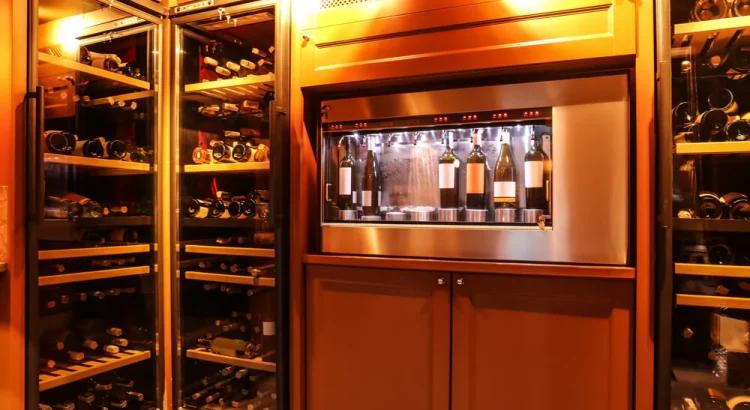Wine racks take up way too much floor space. Those big wooden things that hold thirty bottles? Who has room for that in normal apartments? Plus they look like furniture from the 1980s that nobody wants anymore.
Floating shelves for wine storage make way more sense if done correctly. Key phrase being “if done correctly” because most people screw this up spectacularly. Bottles come crashing down, expensive wine gets wasted, walls get damaged.
Weight is the thing nobody thinks about until it’s too late. Wine bottles are heavy. Six bottles on one shelf equals almost seventeen pounds hanging on someone’s wall. Drywall anchors can’t handle that kind of load, but people use them anyway because they don’t want to find wall studs.
Stud finding drives everyone crazy
Electronic stud finders work maybe half the time. Old houses with plaster walls confuse the sensors. New houses with metal studs create false readings. Meanwhile, wine collections hang in the balance while people tap on walls hoping to hear solid spots.
Stud spacing never lines up with where shelves actually need to go. Building codes determine stud placement, not interior design principles. So choices become either structural integrity or aesthetic appeal. Guess which one most people choose?
Professional installers charge ridiculous amounts for what seems like simple shelf mounting. But they understand load calculations and proper mounting techniques that prevent disaster scenarios. The cost difference between DIY failure and professional installation often equals several bottles of good wine.
Concealed bracket systems look amazing in photos but require precision installation that challenges most DIY skill levels. One measurement error ruins the entire project. Plus weight ratings get questionable when brackets hide inside shelf materials.
Light exposure ruins expensive wine faster than people realize
That gorgeous display near the kitchen window? Terrible idea for actual wine storage. UV radiation breaks down compounds in wine over time. Doesn’t matter if the bottles look pretty when the contents taste like vinegar.
LED accent lighting sounds fancy but generates heat that affects wine temperature. Electrical work complicates installation significantly. Running wires through walls requires different tools and skills than basic carpentry.
Temperature fluctuations stress wine more than specific temperature ranges. Floating shelves near heating vents create thermal cycling that accelerates aging unpredictably. Beautiful display locations often have terrible environmental conditions for wine preservation.
Vibration problems nobody mentions
Wall-mounted storage transmits building vibrations directly to wine bottles. Footsteps upstairs, appliance operation, even music systems can disturb sediment in aged wines. Traditional floor racks isolate bottles better from structural vibrations.
Earthquake considerations vary by location but affect wine storage safety significantly. California wine collectors learned hard lessons about securing wall-mounted storage during seismic events. Floating shelves become projectiles without proper restraint systems.
Real costs shock most people
Quality mounting hardware costs more than entire cheap wine racks. But cheap hardware creates liability issues when expensive collections hang overhead. False economy becomes expensive quickly when bottles start falling.
Professional installation often doubles project costs but prevents catastrophic failures that destroy valuable wines. The labor expense seems excessive until someone calculates replacement costs for destroyed collections.
Material choices affect both appearance and performance dramatically. Solid wood looks great but costs significantly more than engineered materials. Metal shelving provides maximum strength but might clash with home aesthetics completely.
Maintenance requirements everyone ignores
Horizontal surfaces collect debris faster than vertical storage systems. Plus cleaning around wine bottles without disturbing them becomes tedious.
Label preservation becomes important with collectible wines. Moisture, dust, and handling damage labels over time. Floating displays expose bottles to more environmental hazards than enclosed storage systems.
Bottom line reality check
Floating shelves for wine storage work well when properly planned and installed, but the execution challenges trip up most DIY attempts. The combination of weight, precision, and wine preservation requirements demands more skill and investment than people typically expect.
Success requires understanding both structural engineering principles and wine storage science rather than focusing solely on creating Instagram-worthy displays. When done correctly, floating wine storage provides functional beauty that enhances both collections and interior spaces.





